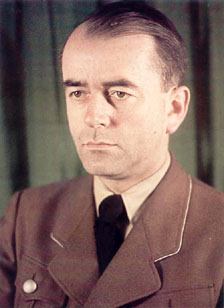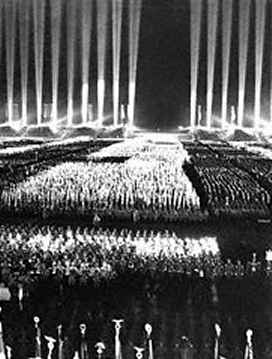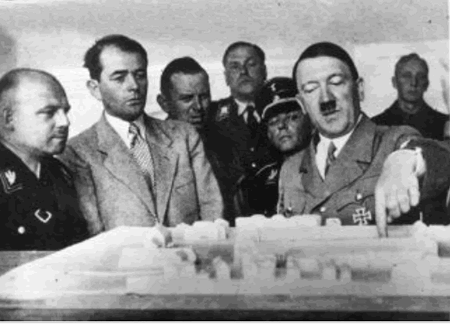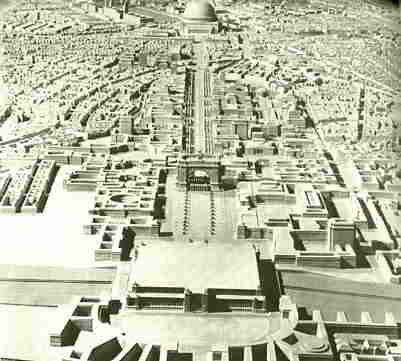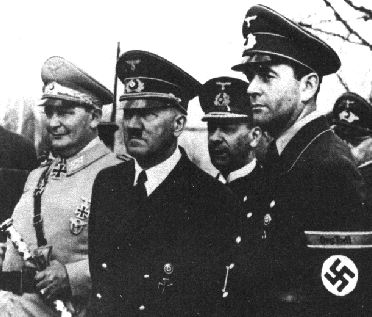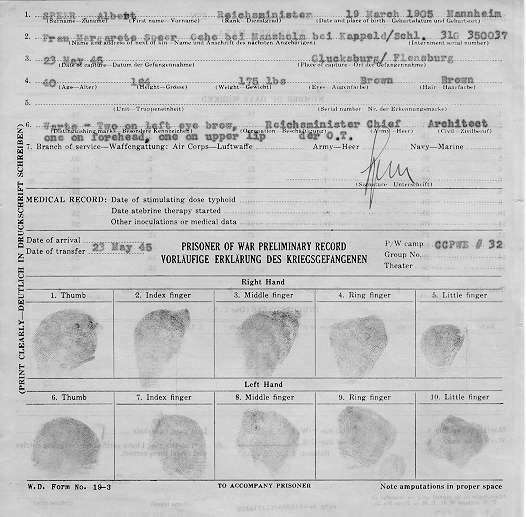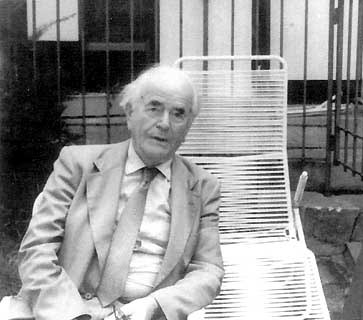Holocaust Education & Archive Research Team |
|
Holocaust Prelude Early Nazi Leaders Nazi Propaganda Nazi Racial Laws Sinti & Roma Kristallnacht The SS SS Leadership Wannsee
Prelude Articles Image Galleries | |||||
Albert Speer
Albert Speer was born on 19 March 1905 in Mannhein, the son of prosperous upper- middle –class family of master builders – his father was one of the busiest architects in the city. Hitler appeared to the young Speer to offer the complete answer to communism and the political futility of the Weimar system. It was the personality of the Fuhrer, rather than the Party itself which attracted Speer, who was able through his close personal relationship with Hitler to realise all his youthful architectural ambitions, to design and build for a new order. In 1932 he received his first commissions from the NSDAP and after 1933 he was responsible for the designs and decorations used in the large Party rallies, beginning with the 1 May celebration on the Tempelhofer field. He perfected the Nazi style of public parades, the monumental liturgy of the movement, using inventive lighting effects and rapidly erected flag-poles with great skill to enhance the Reich Party rallies at Nuremburg. His organizing ability impressed Hitler who came to regard him as an “architect of genius” and gave him a stream of projects to design, including the new Reich Chancellery in Berlin and the Party Palace in Nuremburg.
Speer’s artistic imagination and technological expertise appealed to the frustrated architect in Hitler, who in 1937 appointed him Inspector- General of the Reich, responsible for rebuilding Berlin and other German cities in the neo-classical, monumental style which he favored. Speer’s task was to convert the visions of a grandiose German Reich into an imposing architectural reality. In 1938, Speer who already enjoyed the honorary title of Professor, was made a Prussian State Councilor and received the Nazi Golden Party Badge of Honour.
From 1942 he was also a member of the Central Planning Office and in February 1942 he succeeded Fritz Todt, who was killed in a plane crash, as Minister of Armaments and War Production. He demonstrated remarkable gifts as a manager of industrial enterprises on a gigantic scale. During the next three years Speer was the greatest employer of manpower in Nazi Germany and performed miracles in rapidly expanding war production capacity in spite of massive Allied bombing attacks. Output was increased from 9540 front-line machines and 2900 heavy tanks in 1941 to 35350 machines and 17300 tanks in 1944 under Speer’s relentless prodding and efficiency.
In his role as Minister of Armaments, Speer not only kept the German military machine in the field- thereby prolonging the war by at least two years – he also showed no scruples in exploiting all the slave labour he could get his hands on. The announcement appeared so inadequate that Speer proposed taking a further 90,000 Eastern Workers into “protective custody” by immediate “special action.” The precise meaning of this was that completely innocent armament workers from Poland and Russia, many of them having to come to Germany voluntarily, would be taken up without even a charge.
Though he never sought contact with the conspirators of 20 July 1944, Speer did contemplate killing Hitler, then abandoned the project, attempting till the end to combat with with rational argument the illusions of the fantasy world in the Fuhrerbunker. Speer was found guilty of war crimes against humanity, but it was recognized in mitigation that in the closing stages of the war he was one of the few men who had the courage to tell Hitler that “the war was lost and to take steps to prevent the senseless destruction of production facilities.” Speer was sentenced to twenty years’ imprisonment on 30 September 1946 and the Russians, who had voted to hang him, kept him to the full term.He was released from Spandau prison in 1966. During his imprisonment Speer wrote the first draft of his best-selling memoirs Inside the Third Reich, published in 1970, which gave a detailed, dispassionate account of his years by Hitler’s side and the rivalries within the Nazi hierarchy.
One of the most impressive descriptions of the inner workings of the Third Reich, it strengthened the view of many historians that Speer was a man of integrity and honour in comparison with the criminal leaders who were his associates. His personal qualities notwithstanding, Speer was the prototype of the intellectual technocrat without whose efficient and loyal service the modern totalitarian State could never have consummated its lawless acts of violence. Speer died in a London hospital on 1 September 1981 during a visit to Great Britain.
Copyright: Chris Webb H.E.A.R.T 2007 |
